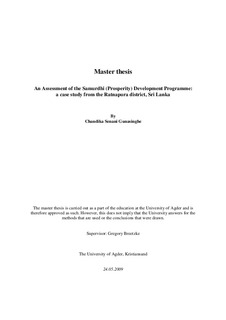| dc.description.abstract | This thesis assesses the impact of the Samurdhi (prosperity) development programme (SDP) on
the livelihoods of its beneficiaries in the Ratnapura district of Sri Lanka. The assessment covers
three main aspects; development, environment and management. First I identify a main research
problem and three sub problems that are directly related to the success of the SDP. Second, based
on the sustainable livelihood approach (SLA), I develop a theoretical framework where a poverty
level of a household is directly and indirectly affected by the activities of the SDP through two
channels; promotional and protective channels. From the theoretical framework I derive four
hypotheses that underlie answers for the identified research problems of the study. Third, to test
the validity of these four hypotheses, I employ both quantitative and qualitative approaches. The
quantitative techniques include the use of various figures, tables, graphs, a transition matrix,
univariate analysis of variance test, a Post Hoc test and estimation of multinomial logistic
regressions (MNLRs).
A total of six MNLRs are run for two models to verify the validity of the first and third
hypotheses. Two models were developed to capture the relationship between the poverty level of
a household and the development of its capital assets. The dependent variable of the first model
has four poverty categories: extreme poor, vulnerable, viable and sustainable households. The
households are categorised into those four groups for 1995 and 2009 based on a range of income
differences around two official poverty lines for each respective year. The dependent variable of
the second model also has four poverty household categories: unsuccessful, struggling,
successful and most successful which are categorised based on the direction of the movement
between the two poverty categories identified in the first model during this time period. The
independent variables of each model are the five categorical variables for the development of
capital assets, one categorical variable for the gender and another three continuous variables:
education, age and number of dependents in the family. Households are randomly selected
covering 17 Divisional Secretariat divisions in Ratnapura district to obtain data for the
quantitative study. In the qualitative study, semi-structured interviews are conducted for
randomly selected 17 beneficiaries of the SDP with a view to find evidence supporting the
second and fourth hypotheses of the study.
The results of MNLRs of two models confirmed that development of natural, physical, human
and financial capital assets are significant determinants of ‘vulnerable poverty’ and of ‘struggling
poverty position’ of a household. More than two thirds of households of the SDP are at a higher
risk of being in ‘vulnerable poverty’ or ‘struggling poverty position’. The poverty level of a
household has declined with the increase of number of capital assets developed. The results of
the qualitative study confirmed that the SDP has not very much concerned about the link
between ecosystem degradation and poverty. The ‘leakage’ and ‘undercoverage’ errors of the
SDP are at a considerable level. | en |
